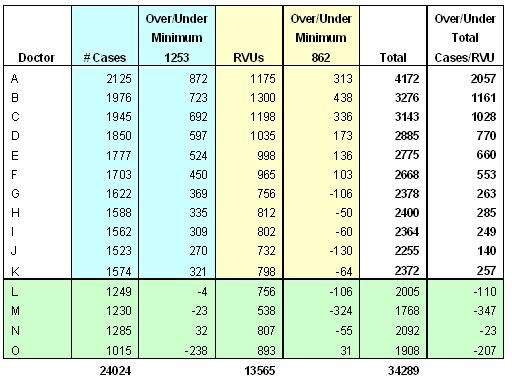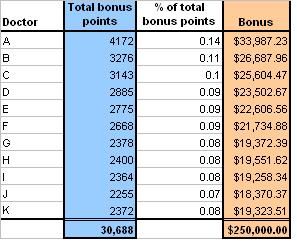Productivity-based compensation: what the numbers say
Assuming our hypothetical radiology practice reached consensus regarding a baseline compensation package, what would be the financial implications to physicians in the group? We begin with a practice profile.
This article is the last in a series addressing the challenge of implementing a productivity-based compensation model in a radiology practice. To put this installment in perspective, it might be important to review that information since the final phase probably represents the least politically charged or disruptive. It discusses the assumptions and results of implementing a specific approach to rewarding high-productivity physicians.
Assuming our hypothetical radiology practice reached consensus regarding a baseline compensation package, what would be the financial implications to physicians in the group? We begin with a practice profile. Volumes have been developed as illustration only (so don’t seek a definitive correlation between the number of cases and RVUs per physician).
Practice profile
- 15-physician radiology practice (all shareholders)
- Average cases per year per physician: 19,786
- Average RVUs per year per physician: 13,611
- Threshold of minimum cases/RVUs for a physician to “pay for him/herself”: 15,038 cases; 10,345 RVUs
- Total “points” in the baseline (cases plus RVUs) to cover established per-physician compensation: 25,383/year
- Monthly performance baseline: 1253 cases (counted by CPT code from billing system) + 862 RVUs = 2115 total points
- Bonus pool is distributed monthly. Available bonus pool for May 2010 performance: $250,000
- Average bonus per physician based on equal distribution among all partners: $16,667
Step 1: Comparison of monthly productivity to baseline expectations
The table below calculates how the performance of each physician compares with the baseline numbers for the month. It is immediately evident that some physicians may meet the desired load for case numbers or RVUs, but not both criteria. Two physicians in the group were able to offset deficiencies in RVUs with their case volumes.
Example (Dr. A):
- Dr. A exceed the case load baseline (1253) by 872
- He exceeds the RVU baseline (862) by 131
- Total points for Dr. A: 4172
- Exceeds baseline total points by 2057

The bottom four physicians in the group did not meet the baseline requirement and are, therefore, not eligible for a bonus.
Step 2: Dividing the bonus pool among eligible physicians
A total of 11 physicians are now eligible to participate in the bonus pool and will receive a percentage of the bonus based on their total points for the month.
Example (Dr. A):
- The 11 physicians participating in the bonus pool generated a total of 30,688 points
- Dr. A generated a total of 4172 points or 14% of the total points. Therefore, he is entitled to 14% of the bonus pool ($33,987.23)
With four physicians ineligible, even the lowest performing physician in the 11 eligible for participation receives more than she would have if the pool were equally divided among all shareholders.

Will radiology ever move to productivity-based compensation?
In our experience, the groups successfully implementing productivity-based models have been newly organized and not burdened with 20 years of history. They are thus in a position to establish new employment agreements rather than modifying existing contracts. It will be exceptionally difficult to change the “everyone shares equally” culture when some physicians will obviously lose income.
Changing an established model will be disruptive at the minimum, but those groups wishing to reward and retain top performers will probably keep productivity discussions on the agenda. The risk of pushing the issue too hard? Disruption could escalate to dissolution and few practices are likely to move willingly into that territory.
Ms. Kroken is a consultant and principal in Healthcare Resource Providers. She can be reached by e-mail at pkroken@comcast.net.
Other articles in the series:
Productivity-based compensation: why it’s such a challenge
At best, productivity-based compensation is a hot topic; at worst, it is potentially the downfall of those promoting it-if not threatening to the very survival of a group. Are there groups compensating on a productivity-based model? Yes, but very few.
Productivity-based radiologist compensation: setting the baseline
Once productivity-based compensation has passed the conceptual stage, the real work begins. And this phase, due to its potential complexity and the reality of potential salary adjustments, often represents the point at which the wheels fall off.
The Reading Room: Artificial Intelligence: What RSNA 2020 Offered, and What 2021 Could Bring
December 5th 2020Nina Kottler, M.D., chief medical officer of AI at Radiology Partners, discusses, during RSNA 2020, what new developments the annual meeting provided about these technologies, sessions to access, and what to expect in the coming year.
Strategies to Reduce Disparities in Interventional Radiology Care
March 19th 2025In order to help address the geographic, racial, and socioeconomic barriers that limit patient access to interventional radiology (IR) care, these authors recommend a variety of measures ranging from increased patient and physician awareness of IR to mobile IR clinics and improved understanding of social determinants of health.